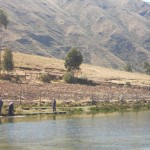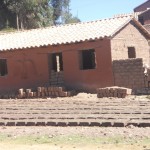Archeology
I don’ t know what I expected to find in Peru, other than a long trail and a big-ass set of ruins at the end. I expected alpaca, llamas, guinea pig. I didn’t expect to find archeology everywhere. It reminded me of Athens, and Rome, the ancient mixed with the modern, built on top of, making itself seen in flashes of stone.
Our second day in Cuzco, Kelly suggested that we see some of the archeological sites in the surrounding valley.
“You can take a cab up to the highest of the four sites and then walk back. It’s like 7 miles. We can do that, right?â€Â We were pretty sure that we could. LeAnna and I were heading out the next day for the 4-day Inka Trail trek. And Kelly was recovering from an Achilles injury. The question was more whether we thought it was a good idea.
“I’ll go ask the front desk about it.â€Â Kelly headed downstairs while LeAnna and I took turns showering and getting ready for the day. When she returned, it was with a big smile on her face.
“It’s $5 for the taxi…and she said we can rent horses!â€Â We stopped pawing through our backpacks and looked up at her beaming face.
“Horses?â€
“Yes! You can ride horsed back down. Should I ask her to call a cab?â€
An hour later we were climbing into a hatchback, the three of us crammed in the back seat, grappling with the stubborn seatbelts.
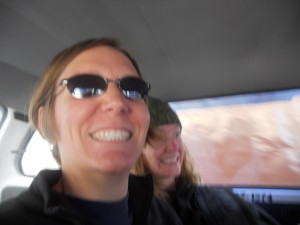
The driver wound through the too-small streets, rattling along the stones, as people jumped out of the way onto sidewalks or up into doorways.
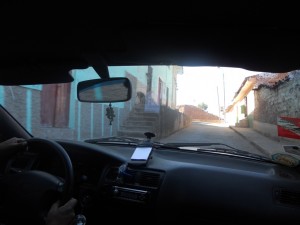
As we drove up and out, we were treated to a view of the city, nestled in the hills high above the distant sea.
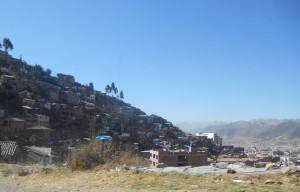
Here we found locals. Real ones. Dressed in the functional clothing that kept them both warm in the morning chill of 12,000 feet and safe form the uv rays of the sun, relatively unfiltered by the thin air.
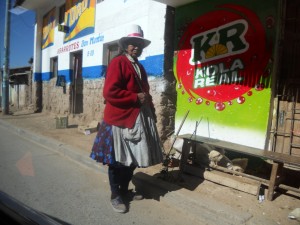
Our taxi driver dropped us at the topmost of the four sites we would see: Tambo Machay. We were greeted by dreadlocked donkeys and llamas rolling in the grasses.
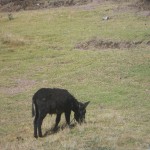
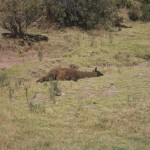
The focal point of this site was water. From the spring running along side the path leading to the ruins, to the incorporation of the water in the beautifully hewn stone, there was no question about its importance here. Beautiful trees grew on the banks of the little spring, shading the path, providing a rare bit of shade. Despite the biting chill in the air, we lingered out of reach of the sun’s searing rays.
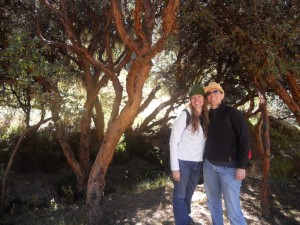
Merchants walked the path, back and forth from a make-shift marketplace at the foot of the ruins, carrying their wares and offering pictures with their livestock.
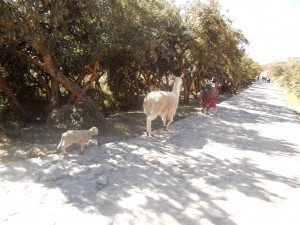
The archeological site was beautiful. The stones were smooth and impeccably placed. The thousand years or so of weather only a mild nuisance to its grand presence. The aqueducts were clearly deeper than they had been when they were originally cut into the rock; worn away by centuries of flowing water.
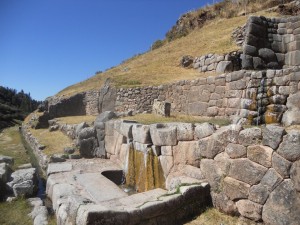
The niches, possibly used to display mummies – a connection with the afterlife – still retained their pink hue, and sharp angles.
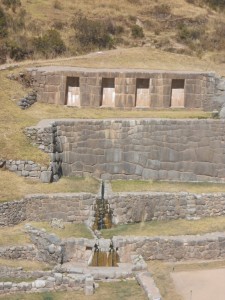
We climbed to a viewing area and surveyed the site. Locals gathered water from the spring, the market spread out in a colorful patchwork of textiles, and a shepherd brought his sheep along the ridge just above the site, the modern mixing seamlessly with the ancient.
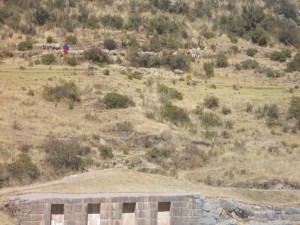
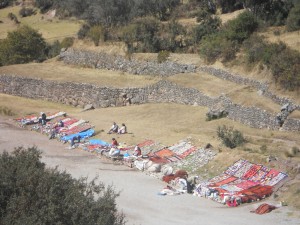
From Tambo Machay we walked down the winding road that had brought us from the city. Our next stop, Puca Pucara, was just across the way, a sentinel balanced over the valley.
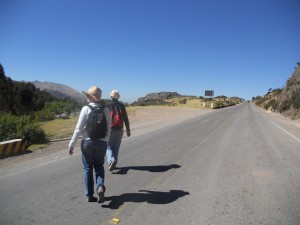
If Tambo Machay was about water, Puca Pucara was about the earth and air. Wind whistled around the site, open on all sides to the elements.
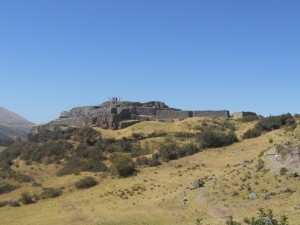
When we walked up we found a young man and woman who wanted to show us the site. “Just for tips.â€Â We declined, but I was intrigued. “Without knowledge, this is just a pile of rocks,†he called after us. We had our guidebook, but his words stuck with me. How interesting that we had traveled all this way to see a pile of rocks. To walk on a pile of rocks that had been so carefully placed. How curious.
On the inside we found carefully constructed windows, small niches, walls built in harmony with the rocks upon which they stood.
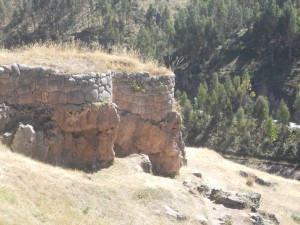
And a cave. LeAnna found the little opening, and we contemplated the intelligence behind entering. None of us had brought a head-lamp, which, in the end, probably saved us from making a foolish decision.
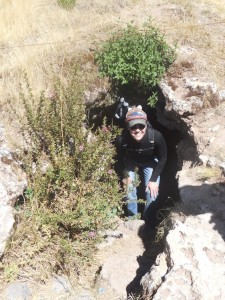
The thorn bush and stinging nettle pleaded with us to turn back. Which we did.
The site had a good number of rooms, layered on top of each other. We climbed stairs cut into the mountain, and spent time looking out at the valley. It was clear that this site was placed so as to offer a view, whether for aesthetic or military purposes. In fact, its purpose as either a hunting lodge or a fortress is still in question.
This was our first introduction to a couple of things. First, the small, uniform niches that decorated the inner walls of the sites. They were perfectly sized to house me.
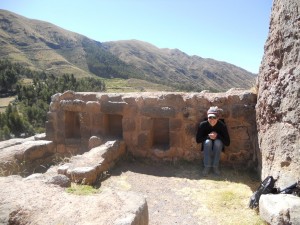
Second, we were introduced to the mountain-shaped rocks carved by the Inka, sacred objects that we would have walked by without knowing they were there. This stone at Puca Pucara was shaped like the entire site of Machu Picchu.
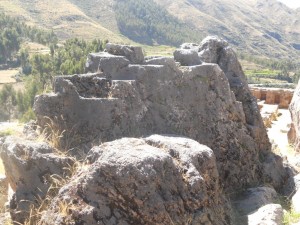
As we walked from the site, Kelly started to feel the uncomfortable crisp that was beginning from spending hours in the high-altitude sun. Even her stylish straw hat provided little protection.
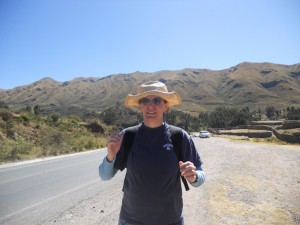
A quick reassignment of clothing resulted in a charming expedition-worthy outfit.
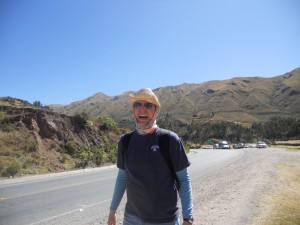
I think that one of the greatest parts of traveling with other people is that I don’t have to be the only one to look like a fool on a regular basis.
The walk between Puca Pucara and the next site of Qenko was the longest leg. We passed a wildlife refuge (about an acre of flooded grassland), fields of great clay bricks drying in the sun, and animals of all sorts.
My favorite was a pig, ridiculously tethered to a clump of grass.
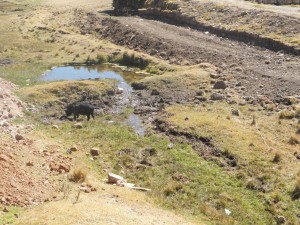
As we turned a corner, the road swinging wide out over the valley, we saw a pack of horses, and two men sitting in the grass. We all smiled and waved. We’d nearly forgotten about the horses! A quick negotiation, and we were on horseback, our guide walking beside us.
My horse was Palomo. A beautiful, dusty white guy who was assigned to me, after I volunteered that I’d ridden before.
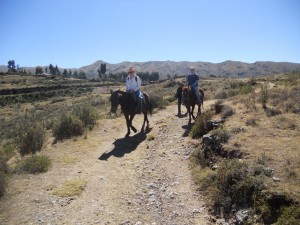
The ride was great. We meandered through the hills, cutting across the country-side, up and down rocky embankments, and splashing through wild springs.
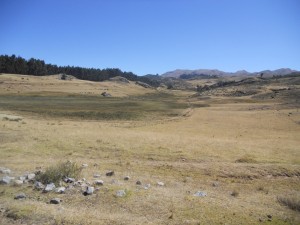
Kelly chatted in Spanish with our friendly guide, and I tried to slow Palomo who clearly preferred to run ahead of the pack. Only once did we stop, our guide ordering me off of the horse, and instructing Kelly and LeAnna to continue on. They looked at me and stayed put as our guide walked over to Palomo and adjusted the saddle, which had slipped back considerably.
With graceful movements, he adjusted the straps and moved with the horse when he sensed the argumentative kick coming.
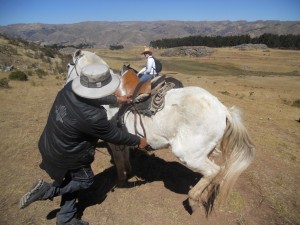
As we neared Quenko, our guide gave us the go-ahead to let the horses run. That was what I’d been waiting for. All thoughts of a slipping saddle were thrust aside as I nudged Palomo on.  And we flew, through the hills of Peru, a huge smile on my face, and a chortling rumbling up from my soul. Up the hill and into a lane filled with other horses, and we landed, Palomo taking charge of where and when to stop.
We hopped down, said our goodbyes and headed up the lane in the direction our guide pointed. We were in a distinctly agricultural area now. Workers were bringing tubs of potatoes from the fields to dry in the sun.
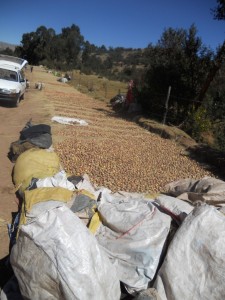
We spent the next while at Quenko. It was lunch time, and we made a familiar picnic of trail mix, dried peaches and cheese. The horses had been a delightful break in the day and we were all smiles as we hydrated and rested our thighs.
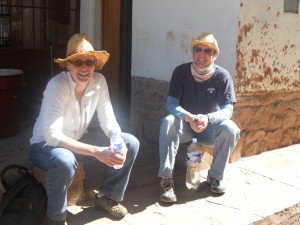
This site was different from the others. It was carved into the rock. Zig-zag channels and natural crags replaced the carefully-formed walls of the other sites. We walked along the path to the site, noting the differences.
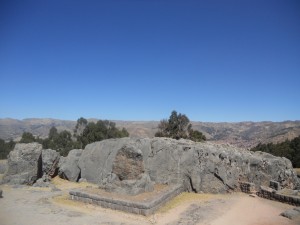
And then we were in the ruins. Literally, in them. Quenko was all about the earth. The great cave in its center was a clear focal point. The altar, carved from “living stone†is thought to have been used for embalming. Mummies were an important part of Inka culture, serving actively as a connection between this world and the next.
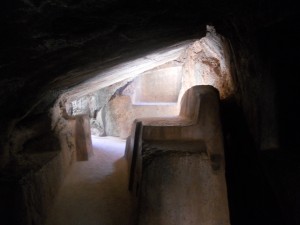
Between the altar and the niche at the far end of the chamber was a great crevasse. LeAnna and looked up at the piece of sky above, and the clear path to the surface. And then we jumped. She did a neat tuck and roll away from the edge, gently sloping down into the bottomless earth. I made a comment under my breath about not having health insurance. Halfway through the muttered doubt, I slammed the edge of my knee into the edge of the unforgiving stone. One day before the longest trek of my life.
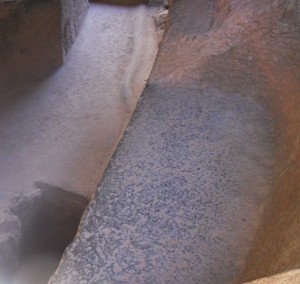
Even with the purple bruise already blooming, I was able to walk, so I shook it off and looked back, thankful that I was above, and not an offering to mother earth.
Up above, we met a young man anxious to talk with us about the site. Not for tips. He introduced himself and his culture and told us he was preparing to be a shaman.
“In two weeks.â€Â He had that long to prepare. He’d been coming to the site every three days for the last 6 months or so, and was ready to join his father, grandfather and great-grandfather as a shaman.
“That is a good sign for you,†he said pointing to two small butterflies that were fluttering together 5 feet from the ground.
He pointed out the phallus-shaped site visible from where we stood – the companion to the uteral cave we’d just escaped from – as well as the male and female mountains visible from where we stood.
We thanked him and walked back to the road. Without horses to guide us, we chose the road that seemed to be headed most directly down and began our journey to the final site. We walked past houses and fields, llamas and soccer goals.
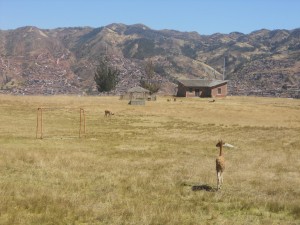
Sacsayhuaman (pronounced “sexy woman”) our final site for the day, was the largest, by far. The Cuzco region is said to be shaped like a puma. Sacsayhuaman is known as the puma’s head. The walls of the site form jagged, tooth shaped battlements – the puma’s mouth. Even from a great distance, it was easy to see why.
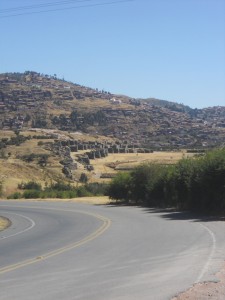
The road took us out of the way, through a small resort, and next to more llama pastures. As we walked past one, a herd of llama escaped, running through an unsecured gate. We considered whether we were morally obligated to attempt to wrangle the llamas.
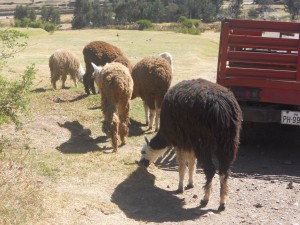
We decided, no. We were not.
Once at the ruins, we found a spot in the shade to relax and hydrate.
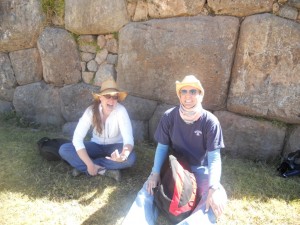
And to take in the enormous Cristo Blanco standing opposite the ancient Inka site.
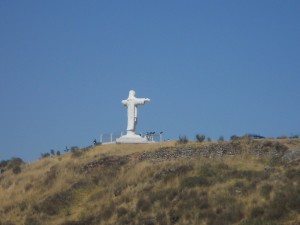
The site was gigantic. We spent at least an hour there and saw a small fraction of what there was to see. The stones that were used were incomprehensively large. One was something like 70 tons.
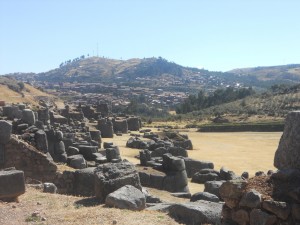
We wandered through the doorways, up the steep stairs, along terraces.
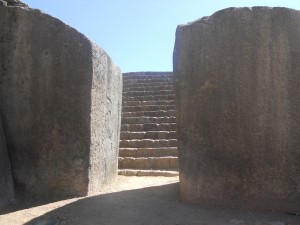
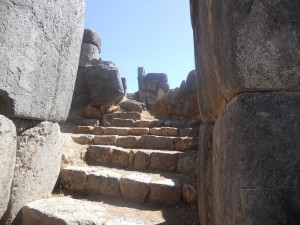
We contemplated the strange, chalk grids marked on the walls, designed to help reconstruct the site in the case of an earthquake.
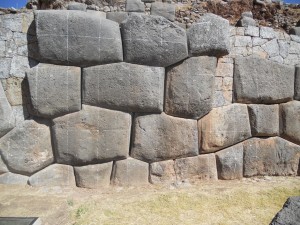
I also perfected my Peru look.
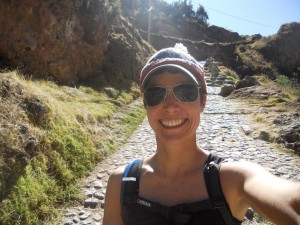
The hat kept me warm, the camelback kept me hydrated, and the tank let me get some sunscreened rays.
And then we went in search of the old Inka trail that our guidebook said we could take form the site down into the city itself. But there were a lot of stone trails. Eventually, we chose one that we thought looked promising, and headed down hill on the worn stones.
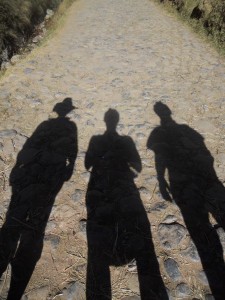
We made our way back into Cuzco, alongside the stray dogs that inhabit the streets. Along side the tiny, old women walking the sidewalks, and the insane motorcycles carrying propane tanks strapped to their metal frames. We walked back into the city with a boy and his grandfather carrying loads of rubbish on their backs.
We walked back into the city and directly into a pizza place.
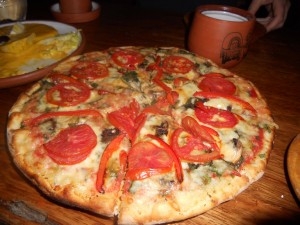
Along with the excellent pizza we had what became our favorite meal, avocado relleno.
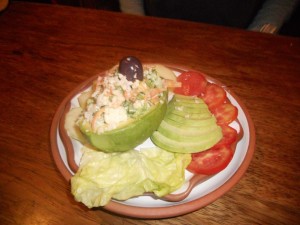
One of the vegetable dishes that we could eat, the avocado relleno was stuffed with boiled vegetables and cheese. It was delicious.
We also sampled a local potato and egg-sauce dish that wasn’t shabby, even if we weren’t exactly sure what we were eating.
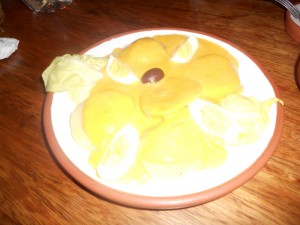
And we each had a local beverage. LeAnna opted for some kind of juice, Kelly for hot chocolate, and I won out with a huge mug of coffee, served concentrated with a beaker of hot water.
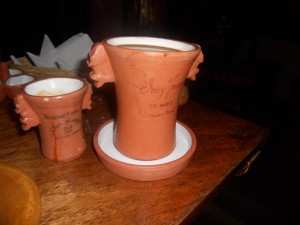
While we ate, the World Cup played in the background. Locals leapt up periodically to cheer on a particularly good play. We spent the rest of the evening doing laundry, walking the Plaza Armas, and in a briefing for the next day’s Inka Trail trek. But generally we were waiting until it was dark enough for us to return to the cake shop for dessert.
Which we did. It was good. I even ate a cheese sandwich. And I think we shared four desserts. But we’d been walking and riding and learning all day, so we were hungry.
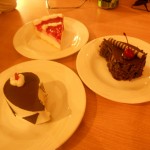
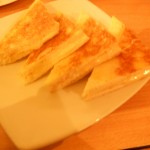
With full stomachs, we went to bed early, ready to wake up at 4AM and catch our shuttle to the Inka Trail, and our next adventure.
August 24, 2010 1 Comment
Cuzco is for addicts
We got into Cuzco early. It was about 8AM when our driver dropped us at our hostel. I’d never stayed in a hostel, and images of bunk beds and shared showers had me a little worried. But when we walked through the blue doors on the steep street, into a beautiful courtyard, I stopped worrying.
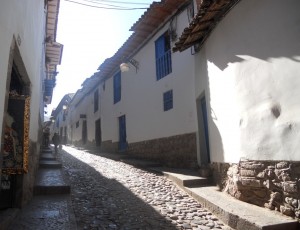
The woman at the front desk took our passports and spoke with Kelly in Spanish. We designated Kelly our primary Spanish speaker, because she’d been studying the most. She was so eager to speak, that even when the other woman told her she could easily speak English, Kelly refused. So LeAnna and I listened and nodded along as Kelly confirmed our reservation and bought 3 huge bottles of drinking water.
Because we were there so early, the room wasn’t quite ready, so we tossed our bags in a corner and struck out to see the city.
Cuzco is high. It sits at 12,000 feet above sea level. I grew up at 7,000, with regular trips to 9,000, but the only time I spent above 12,000 was on Hawaii’s Mauna Loa for my 30th birthday – where we all became giddy from altitude sickness. As we toddled out into the streets, it was with awareness of the distinct shortness of breath that accompanied the clear, blue sky.
We made a circuit around our part of town, stopping at the train station and airline office to confirm parts of the next leg of the trip. Kelly and LeAnna would be continuing on to Lake Titicaca and the Amazon. While they talked timetables and layovers, I consulted Kelly’s guidebook, and dozed lazily in the plastic chairs of the waiting areas. I located the Plaza Armas on the map (the main historic square) and read about its history. Then I turned to the really important thing: food. I had no interest in eating llama, or the local staple, cuy – guinea pig.
There were pizza places everywhere (I’m guessing because the wood-fired ovens used for cooking the cuy are a natural fit for pizzas). The guide book suggested an interesting place off of the plaza, and I filed it away for later.
We tramped through the streets in a jet-lagged haze, making our way to the plaza.
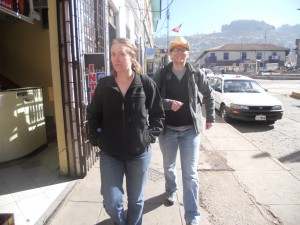
The light seemed strange. Filtered, somehow. It was bright and made the morning feel much later than it was. The streets of Cuzco were coming alive, its cobblestones reminiscent of, but more raw than those of Italy.
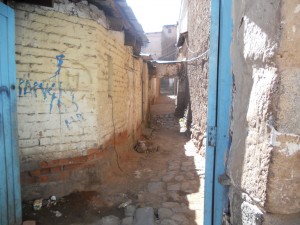
The lanes offered beautiful scenes of daily life mixed with simulated authenticity.
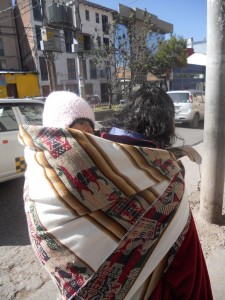
Mothers carried children of varying size and age under blankets wrapped tightly around their backs, little hats poking out from the bundles. I covertly snapped a shot of what was remarkable to me, and completely commonplace to the locals.
Then, just off of the plaza, I saw something colorful and furry.
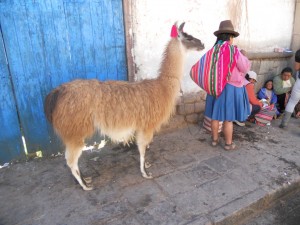
When I ran over to take a picture of an “authentic†Peruvian with a llama, I didn’t know that I was supposed to pay for it. These women make their livings selling snapshots of their clothing, animals and weaving.
The plaza offered great views, bounded on two sides by enormous churches that had competed for the Vatican’s attention and the Pope’s declaration of “most beautiful.â€Â The cathedral (the Pope’s choice) was built on the base of an Inkan temple. The other was a Jesuit church.
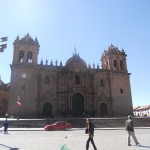
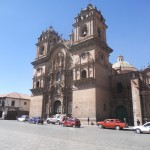
We had a look around at the brown, brushy mountains and the images of pumas everywhere, scoping out a good place to sit.
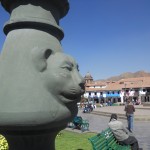
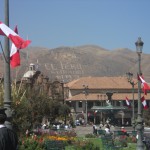
The guidebook said that the plaza still served as a marketplace. By sitting in a park bench, you could avail yourself of vendors. Paintings, jewelry, knick-knacks, tours, paintings, massages and all other manner of items were pedaled to us, as we claimed our view on the plaza.
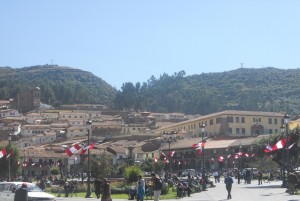
We became more comfortable talking with the vendors. Unlike the vendors on Italian beaches, these vendors would take the time to let us look at their wares, and then move along when we declined, with a polite, “maybe later.â€
The maybe later made us laugh a bit. The third time we heard it we realized that it was ubiquitous.  We decided it must be a way to keep the conversation open for the next time we entered the plaza. Because the vendors remembered us every time we entered the plaza.  “You remember me? I showed you paintings yesterday. I am Pablo Picasso!â€Â The young men sold mostly paintings. The women crafts. Silver jewelry and carved gourds. Textiles and postcards, and everything under the sun, pulled from bags and displayed one after another with immense patience.
With one woman, the most assertive vendor we met by far, I tried out my theory. After looking at her carvings, I smiled and said, “maybe later,†thinking I was politely ending the conversation.
“Maybe later is no good for me, lady,†was her response.  I think I burst out laughing as my self-designated cultural awareness was flung out the window.
The morning nearly over, we headed back to our hostel, stomachs grumbling.
Our front desk friend greeted us with a big smile and a grinned, “como estan?â€Â Our bags were already in our room, and all we needed was our key, which was turned-over heavily to Kelly.
She took command of the huge skeleton key and we made our way up to our second floor room overlooking one of the property’s courtyards.
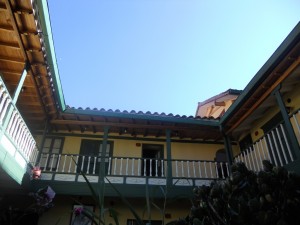
Then we spent some time figuring out the surprisingly complex locking mechanism
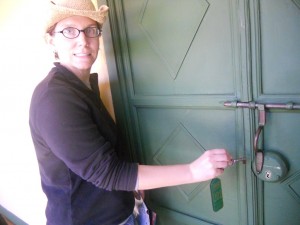
By the time we got in the room and threw down our gear we were appropriately hungry. Working together we came up with a fantastic meal of almonds, dried peaches and an Italian pecorino cheese that I’d smuggled out of Italy and into Peru.
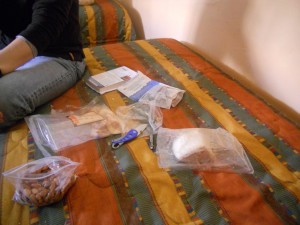
Other places have things that the US doesn’t have. Rooms for more than 2 single travelers, for instance. Our room had four single beds. We each claimed our own and designated the fourth as the gear bed. Then we marveled at our accommodations. Along with the four beds, we had our own, private bath, internet access, breakfast, and all the coca tea we could drink. All for $55 a night. Total.
But back to the coca…
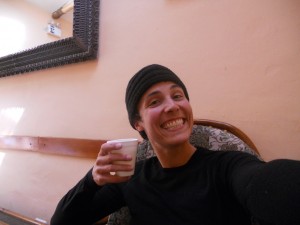
When I told people I was going to Cuzco, they all said the same thing, “drink the coca tea.â€Â I like tea, but I don’t like introducing my body to new addictive substances. Just doesn’t seem like a good idea. So I’d planned to tough it out without the benefit of the coca. But the shortness of breath, sleepiness and vague head pain I was experiencing, along with the pots and pots of coca tea provided by the hostel convinced me that I might be better off joining the locals.
And I was.
LeAnna and I sipped the tea, while Kelly, who would not be spending the next week hiking, looked on. We had no interest in finding ourselves with altitude sickness two days before the four-day trek that was ahead of us.
The tea is made from coca leaves – that’s coca, not cacao – the leaf from which cocaine is extracted. It lowers the blood pressure, and allows your body to absorb oxygen differently. So, in effect, we were doping up for our trek. It did the trick with our headaches. Tea in hand, we all moved into the second, terraced courtyard where scores of traveling students were clutching their own styrofoam lifelines and taking in the mountain air. After a couple of cups, LeAnna and I found ourselves lounging in the sun, our hearts beating insistently in our chests.
Beating aside, we were sleepy. The 20 hours of travel finally caught up to us, so we soon headed to our bunks for a high-altitude nap. In our little beds, we crashed. My last thoughts were of the blood rushing through my heart. LeAnna, on the other hand, was graced with dreams of falling off of cliffs. The coca tea was potent. Kelly slept like a baby.
When we awoke, the day was moving into evening, which meant we could head to dinner. Yay. We pulled out the guidebook once again and I found the restaurant I’d identified earlier. The addicts in us were most excited about a good cup of coffee (because we needed more stimulation), and the “cultural center†atmosphere promised in the book sounded interesting as well.
Books lie. Or they become outdated at an alarmingly fast rate. We found the restaurant, and climbed the spiral staircase to the second floor. We were the only ones there.
We looked out the top floor window onto the streets, and then looked at each other.
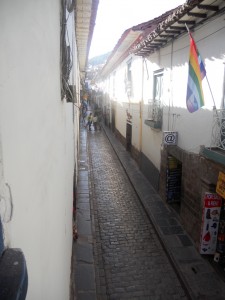
Maybe we were just early for dinner. Maybe there were new owners. Maybe it would pick up.
We were game for staying, but only because we were hungry and had no other lead on food. And we wanted Peruvian coffee. “So, do we drink the coffee?â€Â LeAnna asked the strange question and we looked at her quizzically. “Well, it’s made with water, and I’m pretty sure they haven’t boiled the water for 10 minutes.â€
Damn. None of us had considered this. Parasites weren’t on the list of things we wanted to take home from Peru, and the drinking water wasn’t safe.
A quick debate ensued regarding the drinking of coffee. LeAnna and I came down on the side of “screw it, we’re in Peru, we’re drinking the damn coffee.â€Â Kelly came down on the , “can I have a sip†side.
While we waited for our coffee, we checked out the menu. Along with cuy and other, unidentifiable items, there was a pizza list. Which sounded delightfully comforting. We were adventurous, but hungry. After discounting local fare, we ordered my personal favorite: pizza with olive and pineapple. Delicious. The olives turned out to be Kalamata, a change from the usual, but tasty.
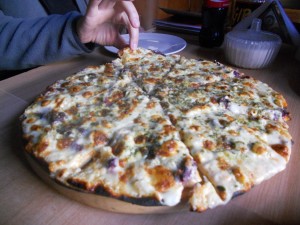
And the pizza was good. Surprisingly so. We gobbled the pizza and slurped tentatively at the coffee. Which was divine. All thoughts of what could be lurking in the water was tossed aside as we tossed back the beautiful-smelling elixir.
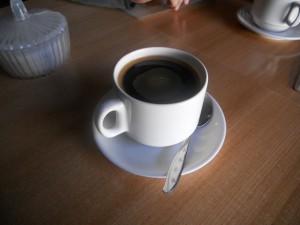
And as we tossed back, we looked up to find the strangest part of the place.
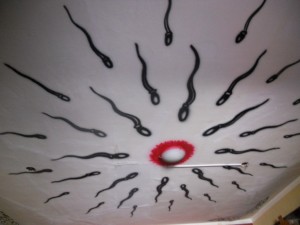
Sperm. Fertilizing a ceiling lamp. Yes, that’s what I said. I don’t know. I didn’t ask. We’re assuming this is the “cultural center” to which the booking was referring. Who knows?
Our stomachs happy, we sat and considered the rest of our time in Cuzco. We’d need another place to eat.  And we might need dessert. While we were a little hesitant to consult the guidebook again, we weren’t ready to accept the recommendations of the hoards of barkers trying to bring in business from the streets.
The guidebook listed a European bakery. A place where we could get more coffee and a piece of cake. Potentially perfect.
Kelly needed an internet café, so we worked our way down the main street, searching for a shop that looked both legit and safe. At every corner was clogged and we were barraged by women with handbills asking if we wanted massages. “Maybe later,†we answered, and they agreed.
When Kelly entered the back of a shop, LeAnna and I sat waiting, catching up on each other’s lives, and musing about the days ahead.   Sitting there talking about the emotional and the mundane, we were treated to a preview of the camaraderie that would thrust itself upon us as we made our way through the truly foreign experience lying in wait.
And then we were walking again, through the streets of Cuzco at dusk, past murals of a maturing justice, and fountains and tourists and locals. Toward pastry.
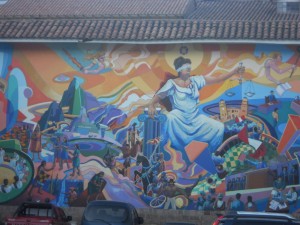
We would visit the pastry shop every night that we spent on Cuzco. We would order a total of 10 desserts in the three visits. Nine of them would be delicious.
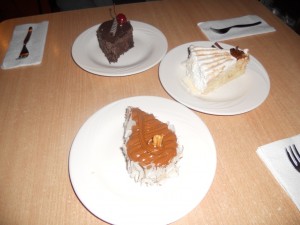
The shop was lovely. White-shirted, black-aproned Peruvian boys waited by the door, hands clasped behind their backs, their dark hair and eyes sparkling at the mix of locals and tourists streaming in and out.
Our three desserts and coffees were consumed, and we laughed lightly, comforted by the familiar look and feel of the place. Caffeinated and sugared, we stepped out into the dark plaza in front of yet another ornate church, where we found a backlit Mary standing watch.
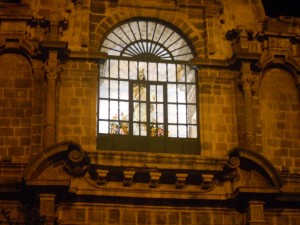
Odd churches were nothing new to me, and I was interested to see the Peruvian flair overlaying the Catholic basics. Kelly and I stepped inside to find one of the strangest church interiors I’ve ever seen. A couple dozen life-sized saints stared down at us from high niches. Wooden or ceramic, each of them was dressed in real clothing. Satin, lace, wool. They all had complete textile clothes. Some had jewels. I wouldn’t have expected this to be so strange, but it really was. Instead of the feeling of benevolence I have felt from the carved statues of saints, this felt like life-sized dolls staring at us as we made a circuit of the large church.
LeAnna, who had wanted to be culturally sensitive, came in to see what was taking us so long. I’m sure we had wide eyes, due to caffeine overload, and the strangeness of the scene.
We weren’t far from our hostel, just on the other side of the Plaza Armas. Despite our sugar highs, we were starting to fade. As we walked back, the night took on a fuzzy, sparkly feeling, the scooters rattling past us along the ancient stones.
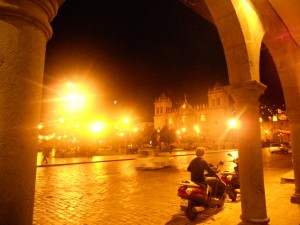
August 16, 2010 2 Comments

